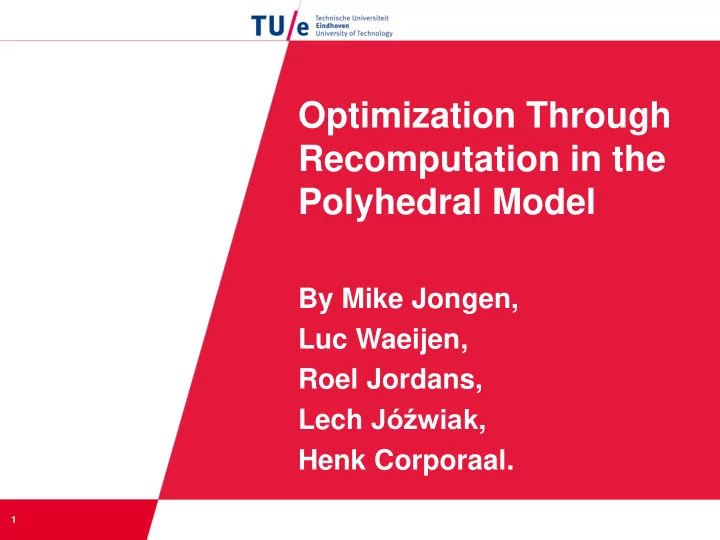

Optimization Through Recomputation in the Polyhedral Model By Mike Jongen, Luc Waeijen, Roel Jordans, Lech Jóźwiak , Henk Corporaal. 1
Contents • Introduction • Related work • Optimizing Through Recompute • Polyhedral modelling • Experimental Results • Conclusion and future work 2
Introduction
Introduction • (Mobile) systems use more artificial neural networks – Artificial vision – Image processing – Speech recognition • Large amount of data accesses • Can be improved by code transformations 4
Current possibilities and extensions • Tiling • Fusion • Distribution • Recomputation/overlapped tiling – Allows for better paralellism – Reduces memory traffic 5
This paper • An example CNN application which includes recompute • Extension of Polly • Demonstration of the effectiveness of recomputation 6
Related Work
Automated polyhedral optimization frameworks • Greatly reduce the effort of translating the original network description into an optimized form • Automatically verifying the validity • Different options: Polly, R-Stream-TF, and PPCG • None of these frameworks provides a method of including recomputation in the optimization space 8
Why do we use Polly • Uses the Polyhedral model for optimizations • Direct integration with the LLVM compiler framework • Adjustable – Add extra functionality – User defined schedules – Automate the process 9
Optimizing Through Recompute
System Architecture Processor Local Memory Global Memory 11
Educational Example 12
Inter Tile Reuse Stored Part of the intermediate image 13
Inter Tile Reuse Stored Part of the intermediate image 14
Inter Tile Reuse 15
Inter Tile Reuse 16
Other Dimensions 17
Methods to handle overlap • Store the overlap globally • Store the overlap locally • Recompute the overlap 18
Global Method • Pixels are stored externally • Small buffer size • Expensive memory accesses 19
Local Method • Pixels are stored locally • Larger buffers required • Cheaper accesses 20
Recomputation Method • Recomputes the pixels • No extra memory required • No extra accesses required • More computations are required 21
Recomputation Tradeoffs 22
Recomputation Tradeoffs Storing the overlap 23
Recomputation Tradeoffs Storing the overlap 24
Recomputation Tradeoffs Storing the overlap 25
Recomputation Tradeoffs Storing the overlap 26
Recomputation Tradeoffs Storing the overlap 27
Recomputation Tradeoffs Recomputing the overlap 28
Recomputation Tradeoffs Recomputing the overlap 29
Recomputation Tradeoffs Recomputing the overlap 30
Recomputation Tradeoffs Recomputing the overlap 31
Recomputation Tradeoffs Recomputing the overlap 32
Recomputation Tradeoffs Storing the overlap Recomputing the overlap 33
Polyhedral Modeling
The Polyhedral Model and Recomputation • Execution order is defined by the schedule • Schedule is singular valued – One execution time per statement – One statement per execution time • Recomputation: – Statements are executed multiple times – Non-singular valued schedules are required 35
Including Recomputation • Support for non-singular valued schedules • Transforming non-singular valued schedules to singular valued schedules 36
Example Stmt[0] [0, 0] [0, 1] Stmt[1] [1, 0] Stmt[2] [1, 1] 37
Example Stmt[0] [0, 0] [0, 1] Old Schedule Stmt[1] [1, 0] Stmt[2] [1, 1] 38
Example Stmt[0] [0, 0] [0, 1] Old Schedule Stmt[1] [1, 0] Stmt[2] [1, 1] Stmt[0] [0, 0] Lexicographical Stmt[1] [0, 1] Minimum Stmt[2] [1, 1] 39
Example Stmt[0] [0, 0] [0, 1] Old Schedule Stmt[1] [1, 0] Stmt[2] [1, 1] Stmt[0] [0, 0] Lexicographical Stmt[1] [0, 1] Minimum Stmt[2] [1, 1] 40
Example Stmt[0] [0, 0] [0, 1] Old Schedule Stmt[1] [1, 0] Stmt[2] [1, 1] Stmt[0] [0, 0] Lexicographical Stmt[1] [0, 1] Minimum Stmt[2] [1, 1] 41
Example Rest of Stmt[1] [1, 0] Schedule Stmt[0] [0, 0] Lexicographical Stmt[1] [0, 1] Minimum Stmt[2] [1, 1] 42
Example Rest of Stmt[1] [1, 0] Schedule Stmt[0, 0] [0, 0] New Schedule Stmt[1, 0] [0, 1] Stmt[2, 0] [1, 1] 43
Example Lexicographical Stmt[1] [1, 0] Minimum Stmt[0, 0] [0, 0] New Schedule Stmt[1, 0] [0, 1] Stmt[2, 0] [1, 1] 44
Example Lexicographical Stmt[1] [1, 0] Minimum Stmt[0, 0] [0, 0] New Schedule Stmt[1, 0] [0, 1] Stmt[2, 0] [1, 1] 45
Example Lexicographical Stmt[1] [1, 0] Minimum Stmt[0, 0] [0, 0] New Schedule Stmt[1, 0] [0, 1] Stmt[2, 0] [1, 1] 46
Example Lexicographical Stmt[1] [1, 0] Minimum Stmt[0, 0] [0, 0] Stmt[1, 0] [0, 1] New Schedule Stmt[1, 1] [1, 0] Stmt[2, 0] [1, 1] 47
Including Recomputation: location 48
Jscop Implementation Conv[i0,i1,i2,i3] → [i0,i1,i2,i3] 49
Jscop Implementation Conv[i0,i1,i2,i3] →[t0,i1,t1,i2,i3] : 0 <= t0 < no_tiles and 0 <= t1 < tilesize and i0 = tilesize ∗ t0 + t1 50
Jscop Implementation Conv[i0,i1,i2,i3] →[t0,i1,t1,i2,i3] : 0 <= t0 < no_tiles and 0 <= t1 < tilesize + overlap and i0 = tilesize ∗ t0 + t1 51
Dependencies Before After OR 52
Experimental Results
Results for different tile sizes 54
Results for different tile sizes 55
Results for different tile sizes and several kernel sizes 56
Conclusion and Future Work
Conclusion • An example CNN application which includes recompute • Extension of Polly • Demonstration of the effectiveness of recomputation 58
Future Work • Legality Checks • Model of the effects • More applications 59
And Finally… • Questions? • Remarks? • Suggestions? 60
Recommend
More recommend